- Submissions

Full Text
Archaeology & Anthropology:Open Access
New Insights on Bronze Age Metallurgy in the Eastern Baltic Region: Archeometallurgical Investigations Based on EDXRF And Lead- Isotope
Agnė Čivilytė*1, Vytenis Podėnas2, Karolis Minkevičius3 and Heide Luik4
1Senior Researcher, Lithuanian Institute of History, Lithuania
2Lithuanian Institute of History, Lithuania
3University of Vilnius, Lithuania
4University of Tallin, Estonia
*Corresponding author: Agnė Čivilytė, Senior Researcher, Lithuanian Institute of History, Lithuania
Submission: December 13, 2022Published: January 05, 2023

ISSN: 2577-1949 Volume4 Issue4
Abstract
In this article, we present archeometallurgical studies of Bronze Age metalwork in Lithuania. Situated on the Eastern Baltic region, Lithuania belongs to the geographical area, which is far away from any metal sources, that have been exploited in the Bronze Age. Yet, the local population required bronze artefacts and metal supply as much as its neighbors. The scarcity of bronze artefacts in the Eastern Baltic raises several questions about the significance of the region during the Bronze Age. However, evidence of metal casting at the fortified hillforts suggests that we may need to reconsider the importance of metal as a raw material. The scope of investigations undertaken here is to ascertain the kind of materials used for the production of bronze artefacts in the Eastern Baltic. In so doing, we apply the Energy Dispersive X-ray Fluorescence (EDXRF) technique, which is used to determine the chemical composition of artefacts to the end of classifying their metallurgical groups. Furthermore, we identify the possible origin of raw materials (deposits) using Pb-isotope analysis as a common practice in order to be able to make statements about trade, import, and or independent production of Bronze Age metal artefacts in the nonmetalliferous region. The interpretations of the results clarify the provenience of copper ores, which were used to produce bronze artefacts in the Eastern Baltic region.
Comparatively, we first studied lead isotope of copper ore deposits in Western Carpathian, Serbia, and the Eastern Alps. Second, we compared lead isotope of bronze artefacts in the same regions. The results indicate that the Western Carpathian and Alpine regions were the principal sources of copper ore used in Lithuania and the Eastern Baltic region. Also, some of the objects from the Late Bronze Age may emanate from Slovakian deposits of the Western Carpathians. We concluded that there are different types of trade and communication such as intraregional, circum-Baltic and interregional connections based on archaeological evidence in the Eastern Baltic region from the Late Bronze Age. We understand metallurgy as a late-emerging sector of the economy driven by innovations such as the development of agriculture and new forms of livestock.
Keywords:Bronze artefacts; Copper ores; Lead isotopes; Chemical composition; Recycling; Import; Trade; Metallurgy; Bronze age economy
Introduction
Our research was prompted by the need to reassess the significance of metalwork in the Eastern Baltic region with a focus on Lithuania1. In the archaeological research, the area, which includes four countries: Estonia, Latvia, Lithuania and Kaliningrad district (Russia) are traditionally described as the Eastern Baltic region [1] (Figure 1). Geographically, it sits at the crossroads of the Scandinavian, Central European, and Eastern European cultures in the Bronze age. This region is unique, because it is far away from any metal sources that have been exploited in the Bronze Age and was necessary for the production of bronze artefacts. Only ca 350 metal objects from the Bronze Age in Lithuania are known [2], which is a very low amount in comparison to what was found in the Scandinavian and Central European regions. Many question the significance of the Eastern Baltic region during the Bronze Age because the assemblage of metalfinds, such as grave-goods and as elements of hoards, is very limited. However, the excavations at the fortified hill-top settlements, such as Asva, and Ridala in Estonia in the late 1940s and mid-1970s, with evidence of bronze casting yielded many more results-thereby raising the prospect of higher metallurgical activity in the region than previously anticipated [3,4]. The discoveries in Estonia were accomplished by similar works in Latvia (Kļanģukalns, Ķivutkalns, Vīnakalns, Mūkukalns etc.) and Lithuania (Narkūnai, Kereliai, Vozgėliai, Velikuškės I etc.). A group of hill-top settlements which contain many fragments of casting molds and crucibles were investigated [5]. The layers with the remains of bronze casting dated back to the Late Bronze Age (1100-400cal BC), based on 108 14C dates from 23 sites [5,6]. These results led some to hypothesize that local metallurgy had only emerged during this very late period. Mindful of the cultural particularities of the above-described region, it is important to understand where the local communities obtained the metal for their artefacts. To answer this question, we first determine the chemical composition of artefacts to build chemical groups using the EDXRF analysis. Then, we conduct a lead isotope analysis. Both methodologies are used in contemporary Bronze age research, with the same aim of ascertaining the origin of different types of copper [7-9]. Furthermore, the results allow us to reconstruct connections between copper suppliers and recipients, and to reflect on cultural interrelationships in the Bronze age. Datasets pertaining to 40 bronze objects from the Eastern Baltic region have been published in a previous study [10]. As such, this paper capitalizes upon the said published results with 27 new datasets from newly analyzed artefacts in Lithuania (Figures 2 & 3) (Table 1). Artefacts selection depends on the accessibility and possibility of sampling. The group of bronze items we publish in this article are all deposited at the Vytautas the Great War Museum in Kaunas2. Chronologically, they belong to different periods of the Bronze age (Period II-VI of Montelius system)3. This allows us to determine the changes in use of copper alloy compositions over time. Furthermore, some of these artefacts seem to have been imported from other regions, such as the spearhead with the loop from Gribžiniai (K/635). This spearhead belongs to the so-called type Sejmo-Turbino and is associated with Eastern European culture [10]. Moreover, the flanged axes from Lithuania were not analyzed yet with one exception-the flanged axe from former Kakeln, Kr. Memel [10]. Also, in the recently published catalog of Bronze Age metal finds from Lithuania [2], no material of metal objects is identified. This may have led some to misinterpret the results because there are items made of non-alloyed copper among metal objects of the Bronze Age. As such, the analysis of these artefacts fills the gap in Lithuanian Bronze Age research and provide a more complete picture of the dataset in the Eastern Baltic region. Conducting such investigations is a fundamental prerequisite to studying Late Bronze Age settlements excavated in Northeastern Lithuania, such as Garniai 1 and Mineikiškės in 2016-2020. These sites revealed new information about the lifestyle and economy of the people of this period [11,12]. The Late Bronze Age economy may be investigated through evidence of subsistence (agriculture, gathering, animal husbandry, hunting and fishing) and craft specialization (pottery production, bone-and antler production and metallurgy). The appearance of metallurgy in the Eastern Baltic region represents an important cultural shift towards the perception of materiality of metal in the region and all that comes with it. In the Late Bronze Age, people started producing counterfeit metal artefacts made of antler, bone, and amber, which reflected the desire to imitate bronze items - probably due to lack of raw metal material [13].
Figure 1:Map of the Eastern Baltic Region.

Figure 2: Analysed bronze artefacts from Vytautas the great war museum in Kaunas.

Figure 3:Map of the analysed artefacts (please find the places in the (Table 1)).
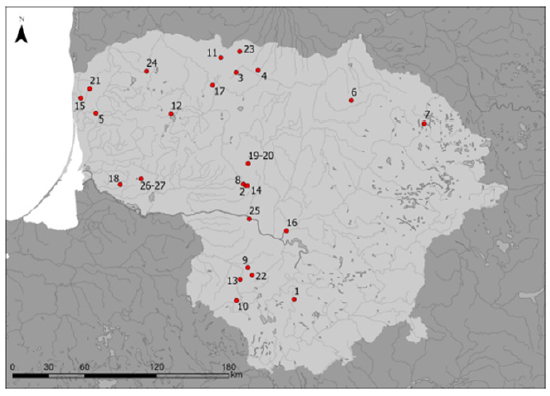
Table 1: Compilation of analyzed bronze artefacts from the Vytautas the great war museum in Kaunas.

Figure 4:The locations of the bronze production sites are based on the collections of technical pottery.
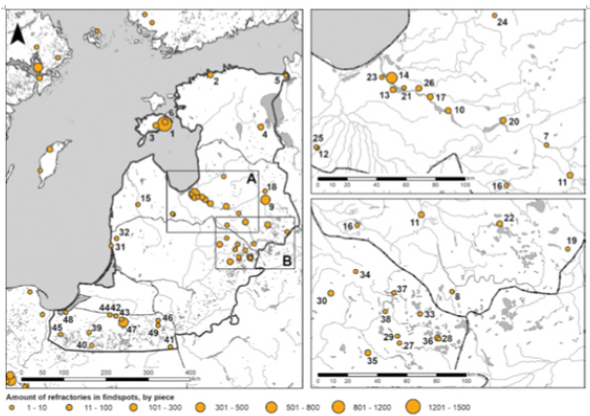
It should be noted that indigenous metallurgy in the region did not emerge until the Late Bronze Age, as metal-casting tools are only found in fortified settlements relating to this period. The single known Early Bronze Age bronze casting mould for flanged axe was not used locally but had ritual significance [14]. As such, metallurgy can be understood as an innovative practice. Local societies started to cast bronze artefacts after or contemporaneously with the emergence of sedentary agrarian subsistence, circa 1400-1200cal BC [15,16]. Therefore, agriculture can be understood as a stimulus for building a new lifestyle with increasing interconnections between different groups. Metallurgy and the approximate doubling of bronze consumption in the Late Bronze Age was a result of economic changes, in which metal, as an exotic material, was a catalysator for building networks. The assemblages of casting moulds were found almost at 49 sites in the Eastern Baltic region (included Kaliningrad region (Russia) and north-western Poland) (Figure 4). Technical pottery, which is entirely made of clay, is divided into groups of casting moulds for ring-shaped artefacts, double-sided casting moulds for axes, or spearheads and less frequently, for ornaments. Only one clay plug for a double-sided casting mould is known in this region. The forms of cast artefacts generally indicate strong Nordic influence [17] Metallurgical activity took place at the settlements within a very short inhabitation period of just a few generations [5,6]. Thus, we argue, that metallurgy was only an episodic, perhaps even a seasonal activity. The amount of bronze that was circulating in the Eastern Baltic region was insufficient and differentiated, i.e., highly dependent on a supply of metal by direct Scandinavian importation or on the movement of metal by the Sambian Barrow culture from the West. Moreover, casting of axes and spearheads indicates a higher metallurgical knowledge than is expected from a local community just starting to become familiar with the concept of casting bronze. Long-term metallurgical activity requires a steady supply of bronze or copper and tin, and for a secure transition of knowledge between different generations [17]. In this cultural context, it is important to clarify what kind of metal was used in the region which was far away from direct sources of copper and tin ores.
Methodology
EDXRF analysis
In this article, we publish the results of the chemical analyses of 27 metal artefacts dated from PII-PVI according to the Nordic Bronze Age (Tables 1 & 2). The arrowhead K/635 was sampled twice in different places. Three artefacts (K 639-2, K631-2, K796- 2) could not be analyzed because the quantity sampled was too low. The objects were sampled using a Proxxon TBM 220 with a 1.5mm drill. After carefully removing the patina, about 40mg of fresh metal drillings are gained. The drill holes are then sealed with color-coordinated restoration wax from the object. The analytical procedure was the same for all the samples. The chemical composition of the samples was determined by Energy Dispersive X-ray Fluorescence Analysis (EDXRF) using an energy dispersive X-ray spectrometer XEPOS HE (SPECTRO Analytical Instruments GmbH). In this instrument, excision is performed by using an X-ray tube with a cobalt-palladium alloy anode in the air, and the material-characteristic X-rays are detected using a Peltier-cooled Silicon Drift Detector (SDD). The samples were excised at two energies (28 and 50keV) with a measuring time of 1.000 seconds in each case. Quantification was performed using the standard calibrated fundamental parameter method [18]. The analyses were conducted at Curt-Engelhorn Centre for Archaeometry GmbH in Mannheim, Germany by dipl. Eng. Elka Duberow. We may undertake a comparative analysis of elements such as silver and nickel, as well as arsenic and antimony in order to gain information about the origin and type of raw materials used [19,20]. While silver and nickel are considered to be elements stable to smelting (and thus directly comparable to ores), the highly volatile elements, arsenic and antimony, experience losses during the smelting process. However, they provide information about the type of ore used, such as fahlore, chalcopyrite or dilutet fahlore copper [20- 22]. The results are presented in double-logarithmic diagrams for the elements silver versus nickel, and arsenic versus antimony (Figures 5 & 6). We added another double-logarithmic diagram showing tin vis-à-vis arsenic to distinguish bronze from copper or arsenic copper (Figure 7). In the silver versus nickel diagram, two groups of materials appear, which can be classified as follows: the artefacts of PII and III resemble the so-called Eastern Alpine copper, which was extracted from chalcopyrite ore. Some objects of Eastern Alpine copper are chemically similar to the Mitterberg sub-type with relatively high nickel and arsenic contents and low silver and antimony contents. Whereas the objects of the younger periods IV and V are comparable to a diluted phalore copper with nickel. These PIV-PV results suggest a mixture of chalcopyrite and phalore copper, which was made to reduce high arsenic and antimony contents [21].
Table 2:Chemical composition of the metal objects, determined using EDXRF, all data in percentage by mass. Elements below the detection limit are not included in the table (Mn <0,01, Co <0,01, Zn <0,1, Se <0,01; Cd <0,01, Te <0,005.

Figure 5:Double logarithmic diagram for the trace elements silver versus nickel for all samples; all data in percent by mass.

Figure 6:Double logarithmic diagram for the trace elements arsenic versus antimon for all samples; all data in percent by mass.
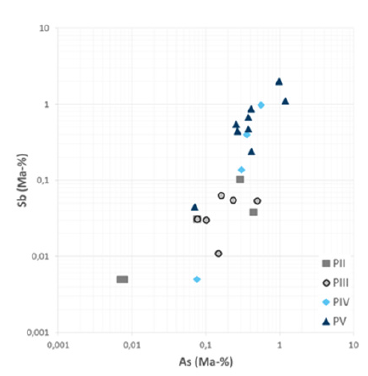
Figure 7:Double logarithmic diagram for the elements tin versus arsenic for all samples; all data in percentage by mass.
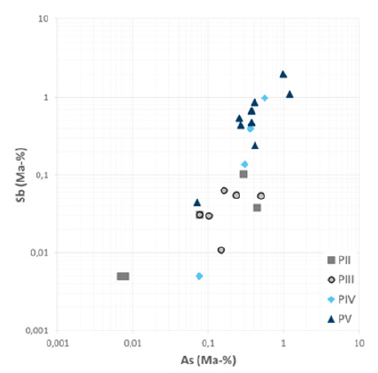
The sequence of metal classes noted in our analyses from Lithuania reflect the general correspondence with Eastern Alpine chalcopyrite copper, which was used in the Middle Bronze Age and is simultaneous to PII-III [22]. Whereas the trend of using trace element-rich material types (especially arsenic and antimony) was characteristic of the Late Bronze Age [22]. In the Late Bronze Age and the Early Iron Age, the use of fahlore copper is mainly observed in bronzes based on diluted fahlore copper and not on pure fahlore copper. Such fahlore production mostly took place in Schwaz/ Brixlegg in the Eastern Alps during the Late Bronze Age to the Early Iron Age [7-10, 22].
Lead isotope analyses using MC-ICP_MS
For the determination of the lead isotope ratios, 19 samples were selected as representative random samples from the entire set (Table 3). Lead isotope ratios were measured using a Thermo Scientific multi-collector mass spectrometer (Neptune Plus) with inductively coupled plasma as the ion source (MC-ICP-MS) following the common procedure. Samples were digested with 6N HNO3 and diluted to 3N HNO3 for column support. An aliquot of these solutions was loaded onto ion exchange columns (Sr Resin) to separate the lead from the sample matrix. After several purification steps, the lead was washed from the columns with 6N HCl. The resulting pure lead solutions were evaporated and taken up with 2% HNO3 (measurement solutions). The mass discrimination of lead occurring in the mass spectrometer is corrected by the addition of Thallium (Tl), for which a ratio of 205Tl/203Tl=2.3871 and an exponential fractionation behavior are assumed. The interference of 204Pb and 204Hg is corrected by the measurement of 202Hg with a ratio of 204Hg/202Hg=0.2293. The in-run precision of the measurement is 0.02 to 0.05% (2σ) depending on the isotopic ratio. The sample-holder of the Thermo Scientific Neptune Plus multi-collector MC-ICP-MS offers space for 48 samples. Standard reference sample NIST SRM 981 was measured after each eight samples to check for instrumental drift and guarantee high-level precision and accuracy. The analysis was conducted at Curt- Engelhorn Centre for Archaeometry GmBH in Mannheim, Germany. Ensuring the quality and reliability of the analyses control analyses on certified standard materials for each series of measurements were carried out. The most important reference material for this is SRM 981, a lead wire certified by the American Society for Testing and Materials in Washington DC and used internationally to check the accuracy of the analyses.
Table 3:Lead isotope data obtained for analyzed metal objects.

The results of the determination of lead isotope ratios of the 19 analyzed artefacts were compared with different available ore samples from several ore deposits from Western Carpathians, Serbia and Eastern Alps. In that regard, it should be noted that lead isotope ratios are used to discuss the origin of copper when it can be assumed that the lead in the alloy originated as an impurity from the copper deposit and was not intentionally added. There is no fixed threshold for distinguishing between these two possibilities, but it is usually assumed that 1% lead or more indicates intentional addition. Typically, the lead isotope analysis is used by comparing lead isotope ratios from objects with lead isotope analysis resulting from ores. However, these ratios do not change from ore to object if they are smelted. This geochemical fingerprint is therefore the same in ores with a common and specific deposit as well as in artefacts that were produced therefrom.
The lead isotope results of objects belonging to PII and PIII are divided into two ranges and show both the lowest and highest values (Figure 8). This is also reflected in the absolute lead content, so that one must infer that two different sources or deposits are involved. The lead isotope values of P IV-V, lie between the data of P II-III, and seem to show a smaller scatter since such diluted fahlore copper may be assumed to be a mixture of two types of materials. In summary, it can be postulated that different deposits over the temporal development from PII to PV, served as copper suppliers.
Figure 8:207Pb/206Pb to 208Pb/206Pb diagram for the objects of the BRONZEKO project divided into objects of the older and younger phases of the Nordic Bronze Age.

Comparison with ore sources
Western carpathians: The copper deposits of Western Carpathians have already been the subject of research in several publications [23], but comprehensive geochemical and archaeometallurgical investigations are only available from a few areas (Figure 9). Although no prehistoric mining has been proven in the Western Carpathians so far, it can be assumed that prehistoric exploitation is likely due to the presence of copper ore deposits therein, as well as the occurrence of tin soaps [24]. The comparison of the lead isotope ratios of the Bronze Age artefacts from Lithuania shows overlaps with the mentioned copper ores from the Western Carpathians. For some objects we can see overlaps such as two flanged axes MA-210539 and 210543 (PII and PIII) and for some objects from PIV and PV. In contrast, most artefacts from PII and PIII show no overlap with the dates of the Western Carpathians. Next, the trace element patterns of the ores were compared with those of the metal objects studied here for the following elements: antimony, nickel, arsenic, and silver. The trace element data of the copper ores come from four different regions of the Western Carpathians: Banská Štiavnica, Nízke Tatra, Poniky/L’ubietová, and Špania Dolina.24. The common copper minerals are found among the primary ores. Namely, chalcopyrite, tetrahedrite, and tennantite (phalore). For the two flanged axes (PII and PIII) a deviating trace element pattern is detected, so that the Western Carpathians can be excluded as a region of origin for these chronologically older artefacts. For objects that belong to periods IV and V, similar trace element patterns may be observed in addition to the overlaps in the lead isotope data. One can observe geochemical similarities between these deposits, which makes the Western Carpathians a prospective region of origin. We may also use analyses of lead isotope ratios and geochemical data of about 30 copper ores from the more distant parts of the Carpathians. Some samples of which were taken from within the framework of the module NW3, extracted from Romania and Serbia. To evaluate the foregoing, the individual deposits were assigned to four geological units according to the locality map4: Rudabanya (Hungary), Inner Carpathian-Alpine metallogenetic belt, ABCD orogen and the so-called “Banatite belt”. The ores from Rudabanya are native copper, in the other three regions carbonatic (malachite, azurite) and sulfidic (chalcopyrite, bornite) ores occur. For the majority of the samples there is no overlap with the ores, only for two flanged axes (MA-210539 and MA-210543, PII and PIII). Granted, there are overlaps with the ABCD orogen and the Inner Carpathian-Alpine metallogenetic belt respectively. However, comparing these findings with trace element patterns showed no similarities, so these deposits must be excluded.
Figure 9:207Pb/206Pb to 208Pb/206Pb diagram for the objects (BRONZEKO) compared to Slovakian Western Carpathian copper deposits.
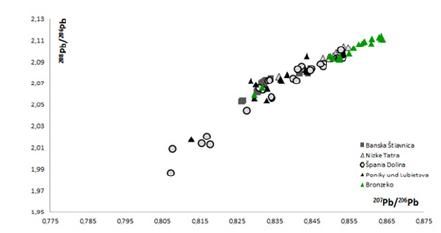
Serbia: There are copper deposits in Serbia such as Bor, Rudna Glava and Majdanpek (Figure 10). In the deposit of Rudna Glava, which was already used in the Aeneolithic, magnetite is found, which is associated with chalcopyrite and pyrrhotite. For Bor and Majdanpek, no traces of prehistoric mining have been discovered so far- likely because modern mining would have erased any traces. The Bor deposit is divided into three mineralization types: massive sulfide (covelline, enargite, pyrite, chalcopyrite, bornite), stockwork type dissemination (copper minerals and pyrite in veins), and phorphyry type (deeper zone). Majdanpek is to be considered as phorphyry type, here chalcopyrite is found associated with bornite, covelline, chalcocite and rarely tetrahedrite, in oxidic zone: malachite, azurite, cuprite and partly digested copper [25]. When comparing the lead isotope ratios between the Serbian deposits and the bronze artefacts investigated herein, no overlap could be found.
Figure 10:206Pb/204Pb to 207Pb/204Pb chart for the objects (BRONZEKO) compared to Serbian copper deposits.

Eastern alps/mitteberg: The Eastern Alps are known as a copper ore supplier from the Early Bronze Age of Central Europe. In the so-called graywacke zone at Mitterberg, phalore and chalcopyrite were mined extensively. The trace element pattern of the Mitterberg chalcopyrite is characterized by low contents of trace elements, except for arsenic and nickel [26,27]. A comparison showed that the lead isotope ratios of the samples investigated here differ from those of the deposits of Mitterberg. Thus, this deposit area is to be excluded as a possible source of raw material.
Comparison of Eastern Baltic and Scandinavian Bronze Artefacts
Figure 11:206Pb/204Pb to 207Pb/204Pb diagram for the objects (BRONZEKO) compared to the Swedish artefacts according to Ling et al. [7].

In the Middle and Late Bronze Age, recycled copper was used for the production of artefacts and mixing different copper ores. Furthermore, it is assumed that extra lead was added to the coppersuch blending may skew our lead isotope analysis because it is difficult to trace it back to the deposit with accuracy. Therefore, a direct comparison of ores and objects may be misleading. As such, the comparison of artefacts with artefacts is recommendable. For that reason, comparisons of Bronze Age artefacts from Scandinavia with their Eastern Baltic counterparts were also evaluated. However, it has to be pointed out that for many regions, comparative data is either limited or unavailable. In turn, this hinders our ability to fully ascertain their areas of origin. Ling et al. published a larger lead isotope dataset of Bronze Age objects of Scandinavia in 2014 [6]. These cover the periods of the Late Neolithic (LN II) and PI to V of the Nordic Bronze Age. Scandinavia’s rich Bronze Age societies were dependent on copper imported from exogenous sources throughout the entire Bronze age period (2100-500 BC). A comparative analysis between the data from Scandinavia and the objects examined here shows large areas of overlap between the two regions, especially objects from later periods (Figure 11). In a previous study, the chemical composition and lead isotope ratios were examined in a total of 40 Bronze Age objects from Lithuania, Kaliningrad, and Belarus [9]. Once again, we observed a similarly clear overlapping between the two regions, particularly with respect to objects from later periods (Figure 12).
Figure 12:206Pb/204Pb to 207Pb/204Pb diagram for the objects (BRONZEKO) in comparison with the study from the Baltic according to Čivilytė [10].
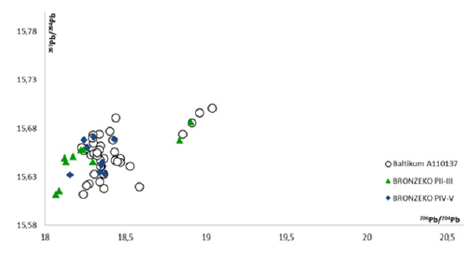
Conclusion
In summary, the Alpine region is a principal source of copper ore used for making artefacts in Lithuania and the Eastern Baltic region, which is one of the most important suppliers of copper in the Central European Bronze and Iron ages. Moreover, some of the objects from the Late Bronze Age may emanate from Slovakian deposits of the Western Carpathians (Hron Valley) [28,29]. These results point to certain regions where networks of Eastern Baltic societies interacted during the Late Bronze Age. The overlapping of Eastern Baltic metal artefacts with Scandinavian ones implies that societies on both sides of the Baltic Sea were involved in circum- Baltic communication. It is very likely that copper was supplied from the same sources of Western Carpathian and Eastern Alps, but in different quantities because among the two mentioned sources, Scandinavians used copper from other Alpine regions, the Atlantic region and the Mediterranean region [7-9, 24]. In the Eastern Baltic Sea region, local metallurgy which emerged in the Late Bronze Age was only a complement to the mainstream economy, and that was just an episodic activity. We see prospects for extending the database of chemical composition using EDXRF and lead isotope ratios of metal artefacts from other museums of Lithuania, Estonia, and Latvia in future research endeavors. While the unstable political situation militates the sampling of artefacts from Kaliningrad, we look forward to analyzing samples collected in 2008 and 2012.
Furthermore, the comparison of the lead ratios from the Eastern Baltic artefacts (with recently published results from Scandinavia and other European regions) can fill the gaps in the Bronze age research and provide a representative picture of production and trade of copper in Europe. The conclusions herein are tentative and may change after further analysis. As such, future investigations are necessary for understanding the dynamic of metal circulation, shifting networks, and the emergence of trade pools in the Bronze Age. Current limitations on datasets in huge parts of Central Europe underscore the importance of a more comprehensive analysis and evaluation of the results across the continent.
References
- Merkevičius A (2005) Material culture and the East Baltic bronze age society. Inter Aracheologia 1: 39-52.
- Merkevičius A (2011) Early metalwork in Lithuania. Versus aureus, Vilnius, Lithuania.
- Sperling U (2014) Aspects of change in the bronze age in the East Baltic. The settlements of the Asva group in Estonia. Estonian Journal of Archeology 18(2S): 334.
- Sperling U (2016) Visitors to the other side: Some reflections on the Baltic Sea as frontier and contact zone in late prehistory. In: Kannike EA, Tasa M (Eds.), The dynamics of cultural borders (Approaches to Culture Theory, 6). University of Tartu Press, Tartu, Estonia.
- Podėnas V (2020) Emergence of hilltop settlements in the southeastern Baltic: New AMS 14C dates from Lithuania and revised chronology. Radiocarbon 62(2): 361-377.
- Podėnas V (2022) Established settlements in the Eastern Baltic region 1100-400cal BC. Doctoral dissertation. Institute of Lithuanian History, Vilnius University, Vilnius.
- Ling J, Stos GZ, Grandin L, Billström K, Hjärthner-Holdar E, et al. (2014) Moving metals II: Provenancing Scandinavian bronze age artefacts by lead isotopes and elemental analyses. Journal of Archaeological Science 41: 106-132.
- Melheim AL, Grandin L, Persson PO, Billström K, Stos GZ, et al. (2018) Moving metals III: Possible origins for copper in Bronze Age Denmark based on lead isotopes and geochemistry. Journal for Archaeological Science 96: 85-105.
- Ling J, Hjärtner HE, Grandin L, Stos GZ, Kristiansen K, et al. (2019) Moving metals IV: Swords, metal sources and trade networks in Bronze Age Europe. Journal of Archaeological Science: Reports 26: 1-34.
- Čivilytė A (2014) Man and metal in prehistory: The attraction of glistening bronze. Diemedis, Vilnius, Lithuania.
- Čivilytė A, Antilgė M (2017) Archaeological research. Lithuanian Institute of History (LII), fund F1-8188, Vilnius, Lithuania.
- Podėnas V, Garniai Mound I, (2018) Detailed archaeological research. Lithuanian Institute of History (LII). Fund F1-8722, Vilnius, Lithuania.
- Luik H, Ots M (2007) Bronze Age double buttons in Estonia. Estonian Journal of Archaeology 11 (2): 122-140.
- Čivilytė A (2004) Made to use? Several meanings of an unknown bronze mold. Archeology of Lithuania 25: 221-232.
- Minkevičius K, Piličiauskienė G, Podėnas V, Kontrimas D, Micelicaitė V, et al. (2022) Agriculture and Environment in Late Bronze Age fortified settlements in the Southeastern Baltic.
- Minkevičius K, Podėnas V, Urbonaitė UM, Ubis E, Kisielienė D (2020) New evidence on the southeast Baltic Late Bronze Age agrarian intensification and the earliest AMS dates of Lens culinaris and Vicia faba. Vegetation History and Archaeobotany 29(3): 327-338.
- Podėnas V, Čivilytė A (2019) Bronze casting and communication in the southeastern Baltic Bronze Age. Lietuvos archeologija 45: 169-199.
- Lutz J, Pernicka E (1996) Energy dispersive X-ray fluorescence analysis of ancient copper alloys: Empirical values for precision and accuracy. Archaeometry 38(2): 313-323.
- Pernicka E (1990) Extraction and distribution of metals in prehistoric times. Yearbook of the Roman-Germanic Central Museum in Mainz 37: 21-129.
- Krause R (1988) Grave finds on the north town terrace of Singen am Hohentwiel. Research and reports on prehistory and early history in Baden-Württemberg, Germany.
- Krause R (2003) Studies on copper and early bronze age metallurgy between the Carpathian Basin and the Baltic Sea. Prehistoric Research (24) Rahden-Westf : Marie Leidorf GmbH, Germany.
- Grutsch CO, Lutz J, Goldenberg G, Hiebel G (2019) Copper and bronze axes from Western Austria reflecting the use of different copper types from the early bronze age to the early iron age. Der Anschnitt (42): 335-362.
- Schreiner M (2007) Ore deposits in Hrontal, Slovakia. Genesis and prehistoric use, In: Pernicka E, Bartelheim M (Eds.), Research into archaeometry and classical studies (3), Rahden/ Westphalia, Germany.
- Nørgaard H, Pernicka E, Vandkilde H (2021) Shifting networks and mixing metals: Changing metal trade routes to Scandinavia correlate with neolithic and bronze age transformations. PLOS ONE 16(6): 1-42.
- Pernicka E, Heidelberg, Begemann F, Schmitt SS, Wagner GA, et al. (1993) Eneolithic and early bronze age copper artefacts from the Balkans and their relation to Serbian copper ores. Prehistoric Magazine 68(1): 1-54.
- Lutz J, Pernicka E, Pils R, Steiner M, Vavtar F (2009) Geochemical characterization of the ore deposits at Mitterberg and in Kitzbü In: The history of mining in Tyrol and its adjacent areas. Milestone-Meeting des SFB-HiMAT. Conference Series. Innsbruck Unversity Press, Austria, pp. 175-181.
- Pernicka E, Lutz J, Stöllner T (2016) Bronze age copper produced at Mitterberg, Austria, and its distribution. Archaeologia Austriaca 100: 19-55.
- Lang V (2007) The bronze age and early iron ages in Estonia. Estonian Archaeology,Tartu University Press, Tartu, Estonia.
- Niederschlag E, Pernicka E, Steifert T, Bartelheim M (2003) Determination of lead isotope ratios by multiple collector ICP-MS. A case study of early bronze age artefacts and their possible relation with ore deposits of the Erzgebirge. Archaeometry 45(1): 61-100.
© 2023 Agnė Čivilytė. This is an open access article distributed under the terms of the Creative Commons Attribution License , which permits unrestricted use, distribution, and build upon your work non-commercially.
 a Creative Commons Attribution 4.0 International License. Based on a work at www.crimsonpublishers.com.
Best viewed in
a Creative Commons Attribution 4.0 International License. Based on a work at www.crimsonpublishers.com.
Best viewed in 







.jpg)






























 Editorial Board Registrations
Editorial Board Registrations Submit your Article
Submit your Article Refer a Friend
Refer a Friend Advertise With Us
Advertise With Us
.jpg)






.jpg)














.bmp)
.jpg)
.png)
.jpg)










.jpg)






.png)

.png)



.png)






